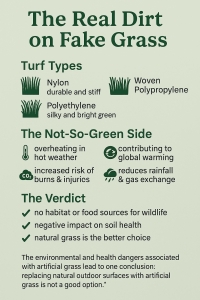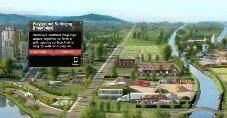Let’s Talk Turf: The Truth About Fake Grass
We get it—artificial turf sounds like a dream. A lawn that’s always green, no mowing, no watering, and no muddy footprints in the house? Yes, please!
But before you roll out the green carpet, let’s dig into the details. Fake grass, also known as artificial turf, comes in a variety of materials, each with its own pros, cons, and quirks. Whether you’re looking for a lush front yard or a puppy-friendly backyard, it helps to know what you’re working with.
Turf Types 101:
Nylon
This heavy-duty turf is built to last. It’s tough, non-toxic, and handles a lot of foot traffic. But… it’s stiff, like, really stiff. Great for sports fields, but maybe not your barefoot backyard oasis.
Woven Polypropylene
Soft and budget-friendly, this type often finds its way into residential and commercial spaces. It looks fairly realistic and won’t break the bank.
Polyethylene
This one brings the luxe. It’s silky, vibrant, and has a super realistic texture. It’s the go-to for gardens and front yards, but it does come with a higher price tag. Bonus: it’s also a good option indoors.
The Bright Side of Fake Grass:
Let’s be real, artificial turf can be pretty appealing. No lawn mower, no sprinkler schedule, no Sunday morning weeding. It stays flawless all year long and is especially tempting for small urban yards or tricky shaded spots.
But like anything, there’s another side to the story.
The Not-So-Green Side 
Artificial turf might look good, but it doesn’t always feel good, especially in the heat. On sunny days, turf can get scorchingly hot, much hotter than natural grass or even concrete. That’s a concern for pets, kids, and anyone who enjoys walking barefoot outdoors.
⚠️ Fun fact (or not-so-fun): Synthetic turf fields can be dozens of degrees hotter than the air temperature!
It’s also worth knowing that artificial turf has a hard surface, which may increase the risk of injuries and skin abrasions, especially on play areas or sports fields.
What About the Environment?
This is where the grass stops being greener on the plastic side.
Natural grass does a lot more than look nice, it absorbs carbon dioxide, releases oxygen, and supports soil life. Artificial turf? Not so much.
According to experts like Dr. Mick Hanley, covering soil with plastic reduces water absorption and gas exchange. That can dry out the soil and harm underground ecosystems, including friendly critters like worms, microbes, and insects.
And don’t forget the bugs! Paul Hetherington from Buglife points out that fake grass blocks access to the soil for burrowing bees and other insects, effectively turning your yard into a food desert for nature’s tiniest workers.
So… What’s the Verdict?
We’re not here to turf-shame anyone. There are situations where artificial grass might make sense, like on balconies or in small areas where natural grass struggles. But it’s good to go in with eyes wide open.
If you’re looking to keep things green and eco-friendly, consider alternatives like:
Drought-tolerant native grasses
Ground covers like clover, thyme, or moss
Wildflower patches or pollinator gardens
Mulch or decorative gravel for low-maintenance landscaping
The bottom line? Fake grass has its place, but it’s worth weighing the trade-offs. A beautiful yard should feel good underfoot and do good for the planet.
 I like to compare synthetic turf to a bad relationship . . . It gets dangerously hot, it’s toxic to everyone around me, it’s unsustainable . . . and it’s really hard to get rid of.” — Diana E. Conway, President, Safe Healthy Playing Fields, Inc.
I like to compare synthetic turf to a bad relationship . . . It gets dangerously hot, it’s toxic to everyone around me, it’s unsustainable . . . and it’s really hard to get rid of.” — Diana E. Conway, President, Safe Healthy Playing Fields, Inc.


